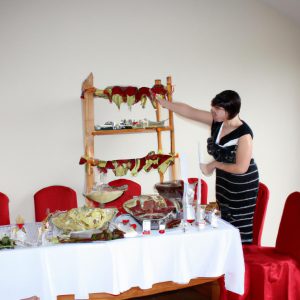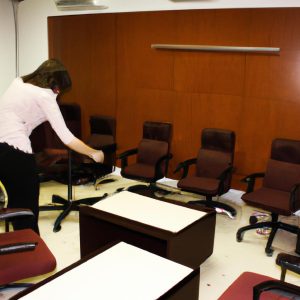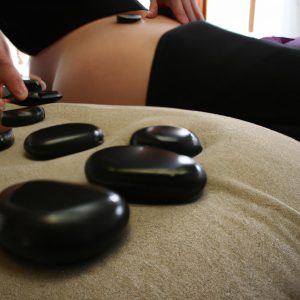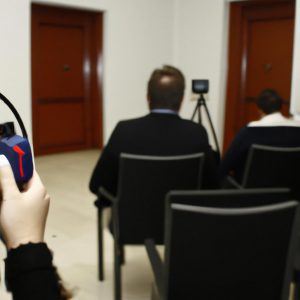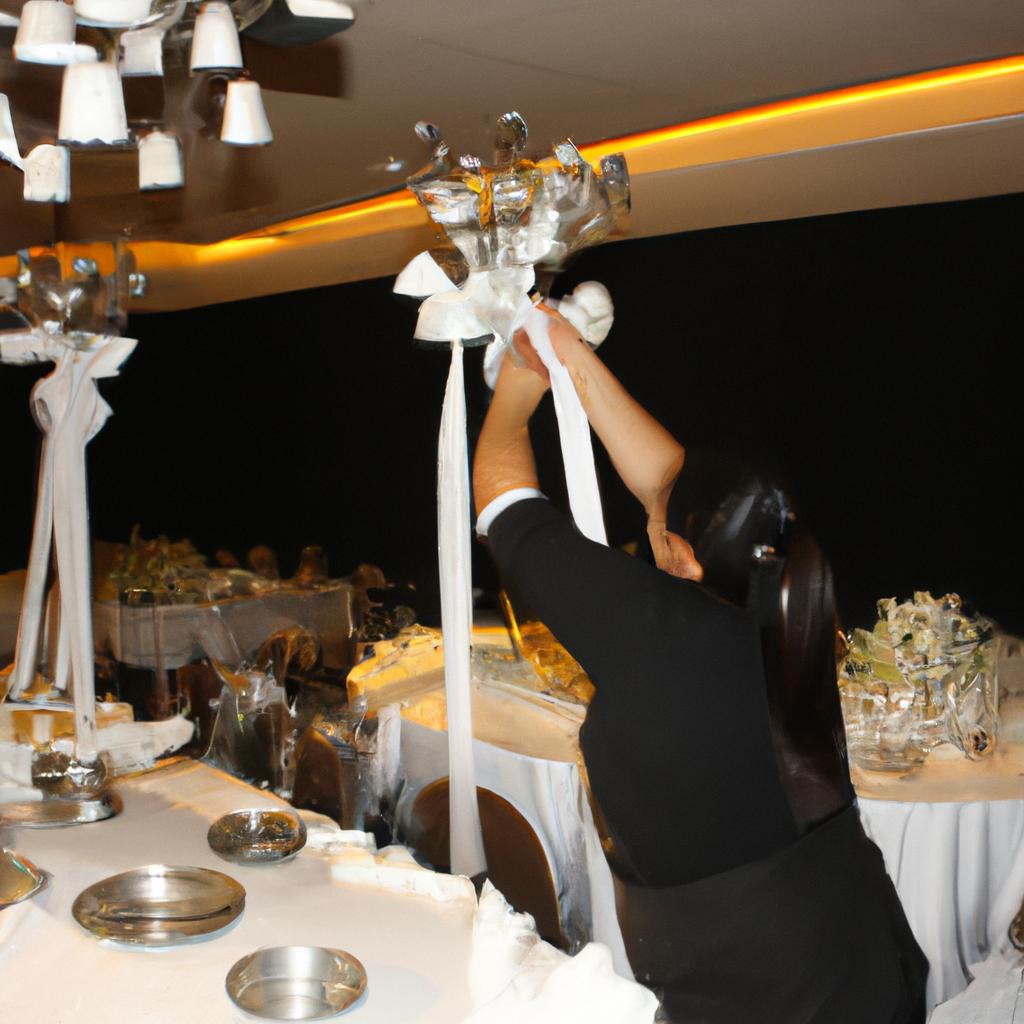
Event planning in hotel and restaurant industries is a complex task that requires meticulous attention to detail and effective management of banquet facilities. The success of an event relies heavily on the ability to create a seamless experience for guests, ensuring their comfort and satisfaction. For instance, imagine a scenario where a prestigious corporate conference is being organized at a renowned hotel. The event planner must not only ensure that the venue provides state-of-the-art audiovisual equipment and comfortable seating arrangements but also coordinate with various departments within the establishment, such as culinary services, housekeeping, and maintenance, to guarantee smooth operations throughout the event.
In this article, we will delve into the intricacies of mastering banquet facilities in hotel and restaurant settings for successful event planning. By examining key elements such as space utilization, menu selection, logistical coordination, and service standards, we aim to provide valuable insights into optimizing guest experiences and achieving client objectives. Furthermore, we will explore best practices adopted by industry professionals to enhance efficiency in managing banquets while delivering exceptional customer service. Understanding these principles can help aspiring event planners or existing hospitality professionals navigate challenges commonly faced when organizing events in hotels and restaurants.
Understanding the Venue Requirements
To successfully plan an event in a hotel or restaurant, it is crucial to thoroughly understand the venue requirements. Let’s consider a hypothetical case study of a wedding reception taking place at a luxurious hotel ballroom. This example will help us explore the specific factors that need to be taken into account when selecting and preparing banquet facilities.
Firstly, one must carefully assess the size and layout of the space available for the event. The dimensions of the ballroom, including its length, width, and ceiling height, should align with the expected number of guests attending. It is essential to ensure that there is ample room for tables, chairs, a dance floor, as well as any additional structures such as staging or audiovisual equipment. Failure to accurately gauge these measurements could result in overcrowding or insufficient space for attendees to move comfortably throughout the event.
Secondly, consideration must be given to the amenities provided by the venue. These may include restroom facilities conveniently located near the banquet area, sufficient parking spaces for guests’ vehicles, and wheelchair accessibility if required. Additionally, it is important to evaluate whether on-site catering services are available or if outside vendors can be accommodated. Assessing these amenities beforehand allows for seamless integration into event planning logistics and ensures guest satisfaction.
Lastly, understanding any restrictions imposed by local regulations or venue policies is vital in order to avoid any legal complications during the event. Noise ordinances may require compliance measures for live music performances or DJ sets playing late into the night. Some venues may have limitations on decorations or open flames due to safety concerns. Familiarizing oneself with such details enables proactive decision-making and prevents last-minute alterations that might negatively impact both budget and overall experience.
In summary, comprehending venue requirements plays a pivotal role in successful event planning within hotels and restaurants. By assessing elements like spatial considerations, available amenities, and regulatory constraints early on in preparation stages—like our hypothetical wedding reception—one can ensure a seamless and enjoyable experience for all attendees. In the subsequent section, we will delve into determining the event capacity while keeping these venue requirements in mind.
Determining the Event Capacity
In order to successfully plan an event in a hotel or restaurant, it is crucial to have a thorough understanding of the venue requirements. This section will delve into the key considerations that need to be taken into account when selecting and utilizing banquet facilities.
To illustrate this point, let’s consider a hypothetical case study involving a corporate conference. The client wishes to host their event at a luxury hotel with multiple meeting rooms and ballrooms available for use. One of the main criteria they have specified is that all venues must be easily accessible for attendees with disabilities. This example highlights the importance of considering accessibility needs as part of the venue selection process.
When determining venue requirements, there are several factors that should be considered:
- Capacity: It is essential to evaluate how many individuals can comfortably fit within each space. This information will help determine which venues are suitable for different types of events.
- Layout: Each event has unique requirements in terms of seating arrangements and configurations. Some common layouts include theater-style, classroom-style, U-shaped, or banquet-style setups.
- Amenities: Depending on the nature of the event, specific amenities may be required such as audiovisual equipment, staging areas, dressing rooms, or storage spaces.
- Technical Specifications: Understanding the technical capabilities of the venue is vital. These can include sound systems, lighting options, Wi-Fi access points, and electrical outlets.
By carefully considering these aspects in relation to your specific event needs, you can ensure that the chosen venue meets all necessary requirements.
Moving forward into the next section about Choosing the Right Layouts
Choosing the Right Layout
Once you have assessed your banquet facilities and their potential, it is crucial to determine the event capacity. This step will help you understand how many guests can comfortably be accommodated in a given space. Let’s consider an example to illustrate this process.
Imagine you are planning a wedding reception at a luxury hotel with a stunning ballroom. The venue management informs you that the maximum capacity of the ballroom is 200 people. However, considering factors such as guest comfort, maintaining adequate spacing between tables, and adhering to safety regulations, you decide to set the event capacity at 180 guests instead.
To ensure efficient event planning and execution, here are some key points to keep in mind:
- Consider fire code regulations: Different jurisdictions may have specific guidelines regarding crowd capacities for public spaces like hotels and restaurants. It is essential to consult local authorities or regulatory bodies to ensure compliance.
- Account for additional services or elements: If your event requires equipment setups like stages, dance floors, or buffet stations, make sure to factor them into your calculations when determining the event capacity.
- Think about different seating arrangements: Depending on the type of event (e.g., formal dinner vs. cocktail party), various seating layouts may affect the overall capacity of the space differently. Experiment with options like theater-style seating or banquet rounds to find what works best for your occasion.
- Consider accessibility requirements: Ensure that your chosen layout allows for wheelchair access and meets any other accessibility needs specified by participants.
By carefully considering these aspects while determining the event capacity, you can guarantee that both organizers and attendees experience a seamless and enjoyable gathering.
| Factors Influencing Event Capacity |
|---|
| Space constraints |
| Type of function |
| Layout preferences |
| Safety considerations |
Moving forward with choosing the right layout for your event space after setting its capacity will enhance both functionality and aesthetic appeal. In our next section on “Choosing the Right Layout,” we will explore different seating arrangements and their suitability for various types of events.
Menu Planning and Catering
Having discussed the importance of choosing the right layout for banquet facilities, let us now delve into another crucial aspect of event planning in hotels and restaurants: menu planning and catering. To highlight the significance of this topic, consider the following scenario.
Example:
Imagine a couple hosting their wedding reception at a luxurious hotel. They have meticulously planned every detail to ensure an unforgettable experience for their guests. However, when it comes to the food selection, they find themselves overwhelmed by numerous options and unsure about what would truly delight their attendees. This is where effective menu planning and catering become indispensable.
Paragraph 1:
Menu planning involves crafting a well-balanced selection of dishes that cater to various dietary preferences and restrictions while showcasing culinary excellence. It requires careful consideration of factors such as seasonality, local ingredients, cultural influences, and theme coherence with the event. By offering diverse options that cater to different tastes and requirements, event organizers can enhance guest satisfaction significantly.
To evoke an emotional response from attendees during menu planning, keep these key aspects in mind:
- Presentation: Ensure visually appealing plating techniques that stimulate appetite.
- Fusion Flavors: Introduce innovative combinations that surprise and please palates.
- Sustainable Choices: Prioritize locally sourced ingredients to support eco-friendly practices.
- Inclusive Offerings: Provide vegetarian, vegan, gluten-free or other specialty items to accommodate all guests’ needs.
Paragraph 2:
Alongside menu planning lies the vital task of coordinating seamless catering services during events. From small corporate luncheons to grand banquets, delivering exceptional dining experiences requires meticulous attention to detail. A dedicated team should be responsible for overseeing everything from table set-up arrangements to prompt service delivery throughout the event duration.
To exemplify how efficient coordination enhances customer satisfaction during catering services, consider this hypothetical case study involving a gala dinner:
Table – Customer Satisfaction Factors
| Factor | Customer Satisfaction Level |
|---|---|
| Timely Service | High |
| Food Quality | Excellent |
| Professional Staff | Exceptional |
| Attention to Detail | Outstanding |
Paragraph 3:
In conclusion, menu planning and catering are pivotal aspects of event planning in hotels and restaurants. By offering a well-curated selection of dishes that cater to diverse tastes and dietary needs, organizers can elevate the overall guest experience. Furthermore, seamless coordination during the provision of catering services ensures customer satisfaction is maximized throughout the event.
With an understanding of menu planning and catering established, let us now explore another crucial consideration for successful events: audio-visual and technology considerations.
Audio-Visual and Technology Considerations
Transitioning from the previous section on menu planning and catering, an integral component of event planning in hotel and restaurant settings is ensuring that audio-visual and technology considerations are well-handled. These aspects play a crucial role in enhancing the overall experience for guests attending banquets or events at these venues.
To illustrate this point, consider a hypothetical scenario where a corporate conference is being held at a hotel banquet hall. The organizers have meticulously planned every aspect of the event, including an impressive lineup of speakers and engaging content. However, due to inadequate audio equipment, some attendees struggle to hear the presentations clearly. This technical glitch detracts from the overall success of the conference despite all other preparations being top-notch.
When it comes to audio-visual and technology considerations, there are several important factors to keep in mind:
- Sound Systems: Ensuring high-quality sound systems are in place is essential for providing clear communication during speeches, presentations, and performances.
- Visual Displays: Utilizing modern projection screens or video walls can enhance visual impact by displaying relevant information or captivating visuals.
- Lighting Effects: Thoughtfully designed lighting setups can create ambiance, highlight key areas such as stages or podiums, and contribute to the overall aesthetic appeal of the event.
- Technological Support: Having dedicated technicians available throughout the duration of an event helps address any unexpected technical issues promptly while minimizing disruptions.
In addition to considering these elements individually, it is imperative to understand how they work together harmoniously within a venue’s physical layout. To achieve seamless integration between technical components and spatial arrangements, event planners often collaborate closely with specialized professionals who possess expertise in audio-visual installations.
By prioritizing audio-visual and technology considerations when planning hotel and restaurant events, organizers can ensure that their efforts culminate in successful experiences for both hosts and attendees alike. Next, we will delve into another critical aspect of event coordination – coordinating with event suppliers – which further contributes to the overall success of an event.
Coordinating with Event Suppliers
Transitioning smoothly from the previous section on audio-visual and technology considerations, we now turn our attention to the crucial aspect of coordinating with event suppliers. This step is essential in ensuring a seamless execution of events held within hotel and restaurant banquet facilities. To illustrate this point, let us consider a hypothetical scenario where an upscale hotel is hosting a corporate conference for 500 attendees.
Coordinating with event suppliers involves managing various external vendors who provide services such as decorations, floral arrangements, photography, and entertainment. In our case study, the hotel’s event planner collaborates closely with these suppliers to meet the client’s expectations while adhering to budgetary constraints. By maintaining clear communication channels and establishing detailed contracts outlining deliverables and timelines, potential issues are mitigated before they arise.
To effectively coordinate with event suppliers, it is imperative to adhere to certain best practices:
- Establishing strong relationships: Building rapport and trust with reliable suppliers creates a network of trusted partners that can be relied upon consistently.
- Conduct thorough research: Identifying reputable suppliers through extensive market research ensures high-quality service delivery.
- Negotiating contracts: Carefully reviewing contract terms and conditions allows for fair pricing, guarantees on quality standards, and contingencies for unforeseen circumstances.
- Regularly assessing performance: Evaluating supplier performance post-event helps identify areas for improvement or potential changes needed for future collaborations.
As seen in Table 1 below, successful coordination with event suppliers requires careful attention to detail across multiple dimensions:
| Dimension | Importance | Benefits |
|---|---|---|
| Quality | High | Ensures customer satisfaction |
| Reliability | Essential | Prevents last-minute cancellations |
| Creativity | Desirable | Enhances overall guest experience |
| Timeliness | Critical | Facilitates smooth event execution |
Table 1: Key Dimensions of Supplier Coordination
In conclusion, coordinating with event suppliers is a crucial aspect of successful event planning in hotel and restaurant banquet facilities. By establishing strong relationships, conducting thorough research, negotiating contracts, and regularly assessing performance, event planners can ensure seamless execution while meeting client expectations. This collaborative effort allows for the creation of memorable experiences that leave a lasting impression on attendees.
